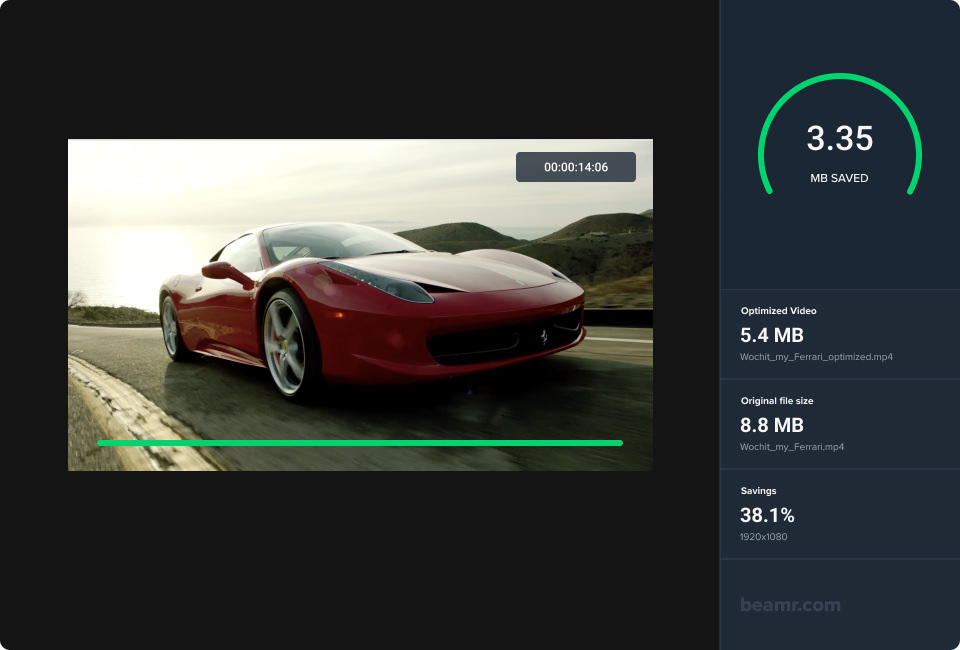2023 is a very exciting year for Beamr. In February Beamr became a public company on NASDAQ:BMR on the premise of making our video optimization technology globally available as a SaaS. This month we are already announcing a second milestone for 2023: Release of the Nvidia driver that enables running our technology on the Nvidia platform. This is a result of a 2 year joint project, where Beamr engineers worked alongside the amazing engineering team at Nvidia to ensure that the Beamr solution can be integrated with all Nvidia codecs – AVC, HEVC and AV1.
The new NVENC driver, just now made public, provides an API that allows external control over NVENC, enabling Nvidia partners such as Beamr to tightly integrate with the NVENC H/W encoders for AVC, HEVC and AV1. Beamr is excited to have been a design partner for development of this API and to be the first company that uses it, to accelerate and reduce costs of video optimization.

This milestone with Nvidia offers some important benefits. A significant cost reduction is achieved when performing Beamr video optimization using this platform. For example, for 4Kp60 encoded with advanced codecs, when using the Beamr video optimization on GPU the costs of video optimization can be cut by a factor of x10, compared to running on CPU.
Using the Beamr solution integrated on GPU means that the encoding can be performed using the built in H/W codecs, which offer very fast, high frame rate, encoding. This means the combined solution can support live and real time video encoding which is a new use case for the Beamr video optimization technology.
In addition, Nvidia recently announced their AV1 codec, considered to be the highest quality AV1 HW accelerated encoder. In this comparison Jarred Walton concluded that “”From an overall quality and performance perspective, Nvidia’s latest Ada Lovelace NVENC hardware comes out as the winner with AV1 as the codec of choice”. When using the new driver to combine the Beamr video optimization with this excellent AV1 implementation, a very competitive solution is obtained, with video encoding abilities exceeding other AV1 encoders on the market.
So, how does the new driver actually allow the integration of NVENC codecs with Beamr video optimization technology?
Above you can see a high level illustration of the system flow. The user video is ingested, and for each video frame the encoding parameters are controlled by the Beamr Quality Control block instructing NVENC on how to encode the frame, to reach the target quality while minimizing bit consumption. The New NVENC API layer is what enables the interactions between the Beamr Quality Control and the encoder to create the reduced bitrate, target optimized video. As part of the efforts towards the integrated solution, Beamr also ported its quality measurement IP to GPU and redesigned it to match the performance of NVENC, thus placing the entire solution on the GPU.
Beamr uses the new API to control the encoder and perform optimization which can reduce bitrate of an input video, or of a target encode, while guaranteeing the perceptual quality is preserved, thus creating encodes with the same perceptual quality at lower bitrates or file sizes.
The Beamr optimization may also be used for automatic, quality guaranteed codec modernization, where input content can be converted to a modern codec such as AV1, while guaranteeing each frame of the optimized encode is perceptually identical to the source video. This allows for faster migration to modern codecs, for example from AVC to HEVC or AVC to AV1, in an automated, always safe process – with no loss of quality.
In the below examples the risk of blind codec modernization is clearly visible, showcasing the advantage of using Beamr technology for this task. In these examples, we took AVC sources and encoded them to HEVC, to benefit from the increased compression efficiency offered by the more advanced coding standard. On the test set we used, Beamr reduced the source clips by 50% when converting to perceptually identical HEVC streams. We compare these encodes to the results obtained when performing ‘brute force’ compression to HEVC, using 50% lower bitrates. As is clear in these examples, using the blind conversion, shown on the left, can introduce disturbing artifacts compared to the source, shown in the middle. The Beamr encodes however, shown on the right, preserve the quality perfectly.



This driver release and the technology enablement it offers, while a significant milestone, is just the beginning. Beamr is now building a new SaaS that will allow a scalable, no code, implementation of its technology for reducing storage and networking costs. This service is planned to be publicly available in Q3 of 2023. In addition Beamr is looking for design partners that will get early access to its service and help us build the best experiences for our customers.
At the same time Beamr will continue to strengthen relationships with existing users by offering them low level API’s for enhanced controls and specific workflow adaptations.
For more information please contact us at info@beamr.com




